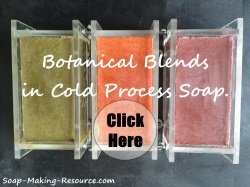Shaving Soap Recipe
Today I am going to share with you my own personal shaving soap recipe. This recipe will produce an incredible lather that is perfect to use for shaving instead of a typical synthetic cream. You will love the natural shaving experience from using this bar. If you have never tried shaving with a natural shaving soap, I really recommend that you give it a whirl!
Also, if you are selling your soaps, I think your customers will enjoy this addition to your line of homemade bath and beauty products.
This soap recipe uses Soap Making Resource's all natural bentonite clay which provides that needed layer of protection and slip on the skin that is an integral characteristic of all shaving soaps. This shaving soap recipe also has a very high percentage of castor oil, which helps give the soap its robust lather that is needed for shaving. Finally, colloidal oatmeal is added to the batch making the bar extra soothing.
Today's shaving soap recipe will make 5 pounds of soap and will work perfectly with either the Soap Making Resource 5lb acrylic soap mold or Soap Making Resource 5lb wooden soap mold.
Below, I will show you exactly how to make shaving soap step by step. Of course, there will be plenty of pictures along the way for your viewing pleasure demonstrating each process.
Below is a picture of the final soap produced by my shaving soap recipe. You can see that it has a natural dark hue due to the bentonite clay.
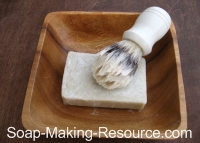
Don't forget to check out some of the other awesome Soap Making Resource soap recipes after you are done with this one!
Soap Making Resource Recipes: |
| Easy Soap Recipe - Beginner |
| Tea Tree Oil Soap Recipe - Advanced |
| Calendula Soap Recipe - Intermediate |
| Check back often as many more will be added this 2011! |
Get the Kit! (Out of Stock)
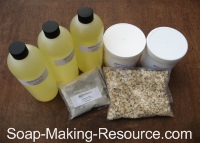
We are pleased to announce that you can now get the shaving soap recipe soap making kit today! Each kit will come complete with all the ingredients needed to make the shaving soap except for the lye and distilled water. Lye can often be found locally and distilled water can be found in most grocery stores! I will provide you with contact information to my own personal source for lye, so if you can't find any in your home town, you will know exactly where to order some at great prices. The kit will include 32 ounces of olive oil, 13.5 ounces of coconut oil, 16 ounces of castor oil, 13.5 ounces of palm oil (RBD), 16 ounces of almond oil, 2 ounces of bentonite clay and 1 ounce of whole oats. This is more then enough to make the 5 pound batch as explained below. Don't forget to also pick up a 5lb acrylic soap mold or 5lb wooden soap mold that will work perfectly with this soap making kit! Finally, you will also get full written instructions for creating your batch.
Shaving Soap Recipe Kit: $46.20 Out of Stock
* Does not include distilled water or sodium hydroxide as explained above.
Of course, all ingredients in this tutorial are also available to purchase in bulk at Soap Making Resource.
Here is my personal shaving soap recipe:
- Olive Oil = 23.9 Ounces (45% of total oils)
- Coconut Oil (76 Degree) = 10.6 Ounces (20% of total oils)
- Castor Oil = 10.6 Ounces (20% of total oils)
- Palm Oil, RBD = 4.2 Ounces (8% of total oils)
- Almond Oil, Sweet = 3.7 ounces (7% of total oils)
- Bentonite Clay = 3 tablepoons
- Colloidal Oatmeal = 4 tablepoons
- Distilled Water = 20 ounces
- lye = 7.269 ounces (206 grams)
*This recipe has a 5% super-fat.
*All measurements are weight measurements, not liquid measurements.
Following is the step by step process (with pictures of course) for successfully making the shaving soap recipe:
Step 1) The first step is to create the lye solution. For this recipe, we need 206 grams of dry lye. Measure this exact amount out into your container.
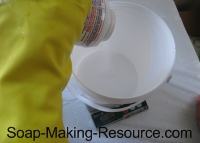
Now weigh out your 20 ounces of distilled water. Remember, even the water is measured out in weight ounces, not liquid ounces.
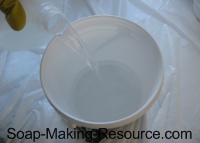
Finally, combine the two substances together. Always pour the dry lye into the water and not the water into the lye!
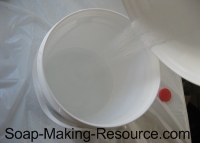
Once the lye and water are combined, you will notice that the solution will start to rapidly heat up. Also, there will be a distinct fume present. Always create your lye solution in a well ventilated area so that these fumes do not become bothersome.
Place your soap making thermometer into the solution and set it off to the side for future use. We want the temperature to drop to around 110 degrees Fahrenheit. 110 degrees Fahrenheit is my personal preferred temperature for making soap. Don't forget to make sure the solution is placed in a safe area where it won't be knocked over! While you complete the other steps in the shaving soap recipe, you don't want it getting in the way!
Step 2) Next, measure out your soap making oils needed for the shaving soap recipe. You need 23.9 ounces of olive oil, 10.6 ounces of coconut oil, 10.6 ounces of castor oil, 4.2 ounces of palm oil and 3.7 ounces of sweet almond oil. Weigh them out in your stainless steel soap making pot. Once successfully measured, melt them down using a very low heat on your cook-top burner. Too high of a temperature here could scorch your oils, so be careful!
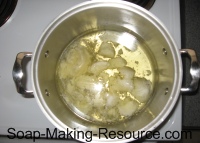
step 3) Now that the oils have melted completely, remove the pot from your cook-top burner and set it off to the side to cool along with the lye. While we wait for the oil and lye to further cool, we will measure out the natural additives that are needed for this shaving soap recipe so that we are ready when the time comes to add the ingredients.
Measure out 3 tablespoons of bentonite clay into a separate container. 3 tablepoons for this five pound batch is a rate of about .6 tablespoons per pound of soap. So, if you are making a bigger batch, use this proportion for the clay amount. Remember, bentonite clay is going to add an extra slip to your bar and provide a thin layer of protection on your skin... both very beneficial attributes to have in a shaving soap.
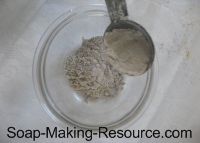
Now measure out 4 tablespoons of colloidal oatmeal. This is a rate of .8 tablespoons per pound of soap. So again, if you are following along and making a bigger or smaller batch, be sure to use the same proportions if you want similar results to mine. Colloidal oatmeal will give your soap very nice soothing properties. I think you will love this ingredient in many of your soaps. It is an especially beneficial addition to a shaving soap recipe!
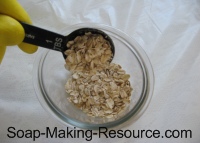
Colloidal oatmeal is simply ground up powdered whole oats. You can easily make your own Colloidal oatmeal by grinding up whole oats in your coffee grinder.
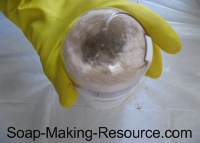
Step 4) Now that your shaving soap recipe additives are measured out, it is time to check on the temperature of the oils and lye solution. For this recipe, we will be combining the two ingredients at around 110 degrees Fahrenheit. If you need to cool the lye and oils down further, you can do this by filling your sink with ice water and placing the holding containers into the freezing water.
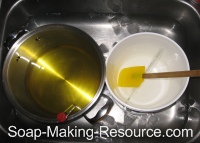
If you need to heat up the oils, feel free to place them back on your cook top burner. If the lye solution needs to be warmed, simply fill your sink with hot water and place the bucket within the heated water until the temperature raises to a satisfactory level.
Step 5) At this point, your lye solution and oils should be created and at a similar temperature. Also, your additives should be prepared and standing by ready to be combined into the batch when the time is right. Finally, we are now going to make soap!
|
Sign Up Today!
*Your information is SAFE with us! |
First, pour the lye solution into the soap making oils being careful not to splash.
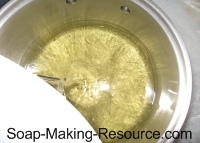
Stir the lye and oils gently using your manual mixing utensil. For the initial mixing, you can use a silicone spatula, a stainless steel whisk, or just about any utensil that can withstand the caustic properties of lye.
Step 6) After about 1 minute, or once the lye and oils combination are an even color and texture, we are going to mix in the shaving soap recipe additives.
First, we will add the bentonite clay. To successfully mix bentonite clay into your batch, it is best to mix the clay into a small portion of your soap first and then pour this small portion of soap into the rest of the batch.
Why? If you pour all the clay into the entire batch of soap, it could be difficult to mix out the lumps of clay that will inevitably be floating in your batch before the soap gets too thick and needs to be poured into a mold. It is better to work the clay into your small soap portion first, while you have plenty of time, and then pour the well mixed small portion into the rest of the batch. Below, you can see a picture of me initially mixing in the clay. As you can see, I only removed about 1 or 2 ounces of soap to mix the clay into.
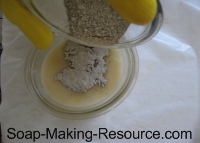
Here is a picture of pouring the small portion of soap mixed with bentonite clay into the rest of the shaving soap recipe batch:
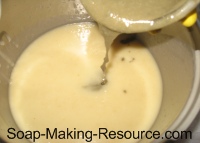
Now take out your stick blender and begin thoroughly blending in the clay. Don't let the soap get too thick yet as we still need to add the colloidal oatmeal.
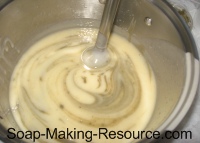
Step 7) Next, we are going to add the colloidal oatmeal to the batch. For this additive, you can just pour the pre-measured amount into your soap and mix in thoroughly.
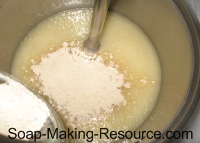
Step 8) Keep stirring all the ingredients until trace is reached... if, of course, you haven't reached trace already with all the mixing you've been doing in the prior steps! If more mixing is indeed still required, it really won't be long before the soap is ready to pour into the mold. Your new creation should be around the consistency of mayonnaise by the time you are done mixing.
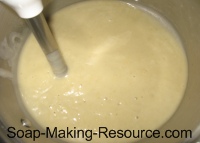
Step 9) Now that your soap has reached trace, pour the entire batch into your five pound mold. As you can see below, I am using the Soap Making Resource 5lb acrylic soap mold. You can also use the Soap Making Resource 5lb wooden soap mold for this shaving soap recipe!
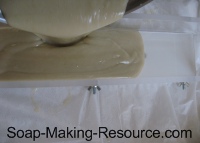
Step 10) Finally, you will need to make the decision as to whether or not you are going to allow the soap to go through the gel phase. If you want your soap to gel, simply insulate your soap very well using towels and blankets to allow the heat from the saponification reaction to build. You can even wrap a heating pad around the outside of the mold to promote gel. This is especially useful for the acrylic molds as they don't hold heat in as well as the wooden molds.
For my soap, I decided not to force it to go through the gel phase as I preferred the more creamy look of non-gelled soap for this shaving soap recipe.
Step 11) Allow the soap to solidify in your mold. This should take anywhere from 12 - 24 hours. Don't rush it! If you try to remove the soap before it is decently hard, you may accidentally damage your log.
Step 12) Once the soap is successfully removed from the mold, cut the log into bars using the Soap Making Resource guided soap cutter. You can cut either wavy or straight bars using our guided soap cutting tool.
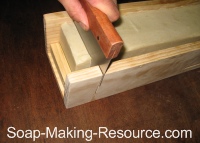
Step 13) Once your log of soap is cut into bars, allow them to cure for about 4 - 6 weeks. This extended cure time will cause your bars to be much harder and last a lot longer.
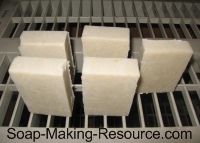
Congratulations! You have successfully completed the shaving soap recipe and have created a wonderful all natural shaving bar!
I truly hope that you enjoyed this tutorial and that it has helped you in some way. Don't forget to pick up the kit if you want to try this recipe for yourself. Or, you can always get the individual ingredients used in this recipe right here at soap-making-resource.com.
Please be sure to check back often, as more recipes and tutorials are always being added to the Soap Making Resource recipe library.
Return from the shaving soap recipe to the soap recipes hub page. Return to the Soap Making Resource Home page.

